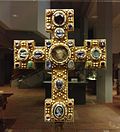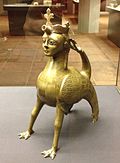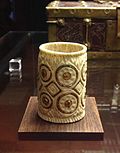Dionysius treasure
The Dionysius Treasure (also: Dionys treasure ) is the collection of relics and treasures of the historic Enger Abbey in Westphalia . It is named after a patron saint of the monastery, Saint Dionysius of Paris . The treasure consists of handicraft items from the Middle Ages. Outstanding is a Bursen reliquary from the 8th century with sheet gold and antique gems , which is counted among the works of the highest order of Carolingian goldsmithing (so-called Engerer Burse ).
Inventory and safekeeping
The Dionysius treasure now consists of 16 of the previous 32 objects that have been in the Berlin Museum of Decorative Arts since 1885 . 14 pieces are shown in the collection at the Kulturforum Potsdamer Platz . Two associated volumes of a missal from 1486 are kept in the manuscript collection of the Berlin State Library.
Parts of the treasure have been lost since 1945 and probably burned at the end of the war, including those from the 13th-14th centuries. An oak chest from the 19th century, in which the treasure was kept until it was transferred to Berlin. The most valuable and art-historically significant pieces have been preserved.
The historical locations of the treasure were the collegiate church St. Dionysius in Enger until 1414 and the St. Johanniskirche in Herford until 1885 .
history
Enger Abbey was founded in 947 by Queen Mathilde . Her son King Otto I furnished it with donations between 947 and 968, including relics of Saint Dionysius of Paris. It can be assumed that during this period of royal donations the monastery also acquired valuable handicrafts, in which the relics were kept and which formed the core of the treasure. Details are not documented.
The oldest name of the treasure can be found in a directory from the first half of the 12th century, which was added to the corresponding evangelist and which is provided with a Christian curse ( anathema ); in it all those who take something away from the "treasure of St. Dionysius" are threatened with the punishment of hell.
Other pieces were added to the treasure between the 11th and 15th centuries, but the circumstances of their acquisition are unknown.
In 1414, Enger Abbey was relocated to the fortified city of Herford for security reasons. The local St. John's Church was the new place of safekeeping for the Dionysius treasure.
After the 15th century, only a few, mostly modest items were added to the treasure. In the course of the Reformation , which the monastery recorded in the 16th century, the liturgical use of the relics must have ended.
In 1810 the monastery was dissolved on the basis of the Reichsdeputationshauptschluss . The new owner of the treasure was the Kingdom of Westphalia and, after its dissolution, the Prussian State in 1813 . He left the treasure in St. John's Church, where the presbytery only occasionally showed it to interested and high-ranking people, for example in 1833 to the Prussian Crown Prince.
On the occasion of his accession to the throne in 1840, the city of Herford sent the Prussian King Friedrich Wilhelm IV. From the treasure the small bowl, which was known as " Widukind's baptismal bowl ", as a tribute, which he assigned in 1845 to the Royal Prussian Chamber of Art, which later became the Museum of Applied Arts .
The treasure was scientifically recorded between 1866 and 1880 and widely known through publications in books, magazines and exhibitions in Munich, Münster and Düsseldorf.
After an attempted theft, the treasure was transferred to the Kunstgewerbemuseum Berlin in 1885.
Art historical importance
The most important parts of the treasure are the Bursen reliquary, the golden reliquary cross, the "Widukind baptismal bowl", the evangelist, the reliquary with large rock crystal and the siren aquamanile .
The Bursen reliquary (" Engerer Burse ") is judged by art historians as "one of the most precious works of goldsmithing that have survived from the early Middle Ages"; it shows as one of the "very few testimonies of the high level of early Carolingian goldsmithing" and is also "one of the most important monuments of occidental enamel art ".
The siren aquamanile is considered to be the “first-rate work of medieval bronze casting” and the “only specimen of this type”.
What is striking about the Dionysius treasure is its heterogeneous composition. It includes both simple manual work as well as goldsmiths of the highest order. It is worth considering that it was not the treasure of an episcopal church, but that of a small and remote monastery that did not have large funds of its own. The treasure thus reflects the eventful history of the monastery and its donations by princely patrons.
It is worth mentioning that the Enger Abbey also had other important works of art, which are not included in the Dionysius treasure, but should be noted in this context: the so-called Widukindepitaph , one of the oldest grave sculptures in Germany from the 11th century, and the Codex Wittekindeus , a major work of Ottonian book illumination .
Archaeological excavations in the Engerer collegiate church from 1971–73 found two valuable goldsmiths, a fibula and a decorative button, which - like the bursa - are dated to the 8th century and are believed to have belonged to the treasury. The pieces are kept in the Widukindmuseum Enger .
Relation to Widukind and Widukind tradition
In addition to the veneration of Saint Dionysius, the Enger monastery also cultivated an increasing, saint-like veneration of the Saxon "Duke" Widukind , who came from the 8th century : whose church and burial place were suspected to be in Enger. Due to this Widukind tradition (Balzer), pieces of the monastery treasure were also associated with the Saxon nobles, in particular the “baptismal bowl” was considered one of those gifts from Charlemagne to Widukind that are mentioned in contemporary Franconian sources . The setting of the bowl is more recent, the age of the serpentine stone cannot be determined, probably antique. For the bursa, such a connection is possible from an art-historical point of view, but it cannot be proven; it was first formulated by research in the 19th century.
Components of the Dionysius treasure
| No. | image | designation | Explanation | origin |
|---|---|---|---|---|
| 1. |

|
Bursen reliquary (" Engerer Burse ") | Gold and silver sheet, stones, pearls, cell enamel, wood core. The reliquary can be opened from below, today it is empty. | Frankish Empire, 8th century. |
| 2. |

|
Shell and sheath
("Widukinds baptismal bowl") |
Green serpentine, gilt bronze. Inscription on the frame: + MUNERE TAM CLARO DITAT NOS AFFRICA RARO (“Africa gives us such a magnificent and rare gift”). Sheath made of linden wood, painted. | Germany, 12th century. |
| 3. |

|
Golden reliquary cross | Gold sheet, pearls, stones, Carolingian rock crystal cut, niello, wood core. Inscription: + DE LIGNO DO (MI) NI ("From the Lord's Wood"). | Westphalia or Lower Saxony, 12th century (late Gothic cross base) |
| 4th |

|
Evangelist | Silver, partially gold-plated, wood core. Liturgical manuscript, contains an attached treasury index with anathema. | Manuscript: St. Gallen, 10th century.
Front cover: Westphalia, 12th century. |
| 5. |

|
Reliquary with a large rock crystal | Silver, partly gold-plated. The rock crystal is one of the earliest preserved hollow cuts. Originally there were relics in the cave. | Westphalia (Osnabrück?), Around 1220. |
| 6th |

|
Siren Aquamanile | Bronze. Ritual watering vessel in the shape of a siren (hybrid of woman and bird). | Hildesheim, around 1230. |
| 7th |

|
Pyxis | Bone. Presumably reliquary box, the lid of which has been lost. | Lorraine ?, 10th century. |
| 8th. |

|
Reliquary Capsule | Silver, gold-plated. Relic capsule cut in half. The image design shows the beginning and completion of the salvation process. | Northern Germany, 15th century. |
| 9. |

|
Two large presentation crosses | Silver sheet, wood core. Two largely identical processional crosses of simple design. | Northern Germany, 15th century. |
| 10. |

|
Small reliquary cross | Copper, formerly silver-plated, hollow inside. Rear opening for retrieving relics inside. | Northern Germany 15th century. |
| 11. |

|
Fragrance capsule
(" Muskrat ", "scented apple") |
Silver, chased, engraved. Two-half ball for the recovery of valuable fragrances or disease-repellent substances. Probably worn on the belt. | Germany, 15th century. |
| 12. |

|
Choir jacket clasp | Silver, chased, partly gilded. An inscription refers to the canon Heinrich Fürstenau as the founder. | Westphalia (Osnabrück?), Dated 1512. |
| 13. |

|
Cover sleeve | Limewood, painted. Simple container for hosts or relics. | Northern Germany, 15th century. |
| 14th |

|
Leather box | Leather, cut, embossed. An inscription indicates an originally profane purpose of the box. | Germany, 15th century. |
| 15th | No picture | Two silk embroidery | Corporal box with embroidered cover for storing goblet cloths . Elongated pillow. | Northern Germany, 15th century. |
| 16. | No picture | Missal (two volumes) | Manuscripts with paintings. Leather bindings on wood. The volumes contain the summer and winter parts of all liturgical texts, prayers and chants used in the course of a year. | Osnabrück, 1486. |
Individual evidence
- ^ Kötzsche: The Dionysius treasure . In: Stadt Enger - Contributions to the history of the city 2 . Enger 1983, p. 43
- ^ Kötzsche: The Dionysius treasure . In: Stadt Enger - Contributions to the history of the city 2 . Enger 1983, p. 46.
- ^ Kötzsche: The Dionysius treasure . In: Stadt Enger - Contributions to the history of the city 2 . Enger 1983, p. 55.
- ↑ cf. Uwe Lobbedey: The excavations in the collegiate church at Enger 1, preliminary excavation report. In: Preservation of monuments and research in Westphalia , p. 179.
- ↑ cf. Ute Specht-Kreusel: Widukind - Reception-historical approaches to a historical and unhistorical figure . In: Olaf Schirmeister, Ute Specht-Kreusel (eds.): Widukind and Enger (= City of Enger - Contributions to City History 8). Publishing house for regional history, Bielefeld 1992, p. 9f.
literature
- Dietrich Kötzsche : The Dionysius treasure . In: Stadt Enger - Contributions to City History Volume 2, Enger 1983, pp. 41–62.
- Rainer Pape: The loss of the Dionysius treasure . In: Rainer Pape: Sancta Herfordia. History of Herford from the beginning to the present . Herford 1979, pp. 269-272.
